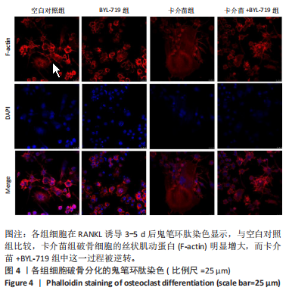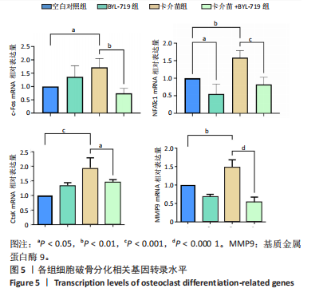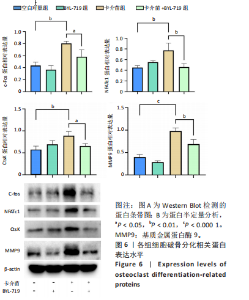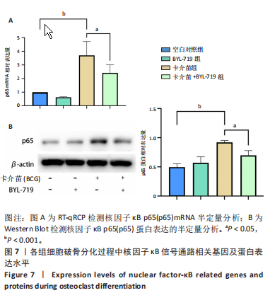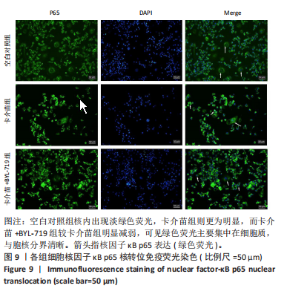Chinese Journal of Tissue Engineering Research ›› 2025, Vol. 29 ›› Issue (2): 355-360.doi: 10.12307/2024.833
Previous Articles Next Articles
Effect and mechanism of BYL-719 on Mycobacterium tuberculosis-induced differentiation of abnormal osteoclasts
Zhang Jun1, Guo Jian1, Jia Qiyu1, Tang Lili1, Wang Xi1, Abudusalamu · Alimujiang1, Wu Tong1, Maihemuti · Yakufu2, Ma Chuang1
- 1Department of Traumatology and Orthopaedics, The First Affiliated Hospital of Xinjiang Medical University, Urumqi 830054, Xinjiang Uygur Autonomous Region, China; 2The Sixth Affiliated Hospital of Xinjiang Medical University, Urumqi 830054, Xinjiang Uygur Autonomous Region, China
-
Received:2024-01-02Accepted:2024-01-23Online:2025-01-18Published:2024-05-25 -
Contact:Ma Chuang, MD, Professor, Chief physician, Department of Traumatology and Orthopaedics, The First Affiliated Hospital of Xinjiang Medical University, Urumqi 830054, Xinjiang Uygur Autonomous Region, China -
About author:Zhang Jun, Master candidate, Department of Traumatology and Orthopaedics, The First Affiliated Hospital of Xinjiang Medical University, Urumqi 830054, Xinjiang Uygur Autonomous Region, China -
Supported by:Open Research Project of State Key Laboratory of Causes and Prevention of High Morbidity in Central Asia under the auspices of the Ministry of Education of China and the Ministry of Science and Technology of China, No. SKL-HIDCA-2022-JH3 (to MC); National Natural Science Foundation of China, No. 82260425 (to MC); Key Research and Development Special Project of Xinjiang Uygur Autonomous Region, No. 2022B03013-6 (to MC); “Tianshan Talent” Science and Technology Project of Xinjiang Uygur Autonomous Region, No. 2022TSYCCX0113 (to MC)
CLC Number:
Cite this article
Zhang Jun, Guo Jian, Jia Qiyu, Tang Lili, Wang Xi, Abudusalamu · Alimujiang, Wu Tong, Maihemuti · Yakufu, Ma Chuang. Effect and mechanism of BYL-719 on Mycobacterium tuberculosis-induced differentiation of abnormal osteoclasts [J]. Chinese Journal of Tissue Engineering Research, 2025, 29(2): 355-360.
share this article
Add to citation manager EndNote|Reference Manager|ProCite|BibTeX|RefWorks
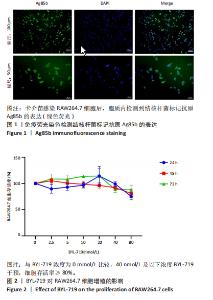
2.1 细胞免疫荧光观察体外结核感染情况 用MOI为10的卡介苗感染RAW264.7细胞4 h,然后用20 μg/mL庆大霉素杀死细胞外细菌,用Ag85B抗体进行细胞免疫荧光染色。结果显示,RAW264.7细胞的细胞质中出现了明显的Ag85B阳性信号,见图1。 2.2 CCK-8检测BYL-719对RAW264.7细胞的增殖与毒性作用 用不同浓度BYL-719(0,2.5,5,10,20,40, 80 nmol/L)分别处理RAW264.7细胞24,48,72 h。CCK-8检测结果分析显示,与0 nmol/L相比,在40 nmol/L及以下浓度的BYL-719干预下,各组细胞存活率大于80%,说明这些浓度的药物没有细胞毒性,见图2。在随后的实验中BYL-719使用浓度为40 nmol/L。 2.3 抗酒石酸酸性磷酸酶染色检测BYL-719对结核杆菌感染下破骨分化的影响 用100 ng/mL RANKL诱导各组RAW264.7细胞向破骨分化3-5 d,抗酒石酸酸性磷酸酶染色测定各组RAW264.7细胞向破骨分化情况。抗酒石酸酸性磷酸酶主要存在于破骨细胞和肺泡巨噬细胞,它反映了破骨细胞的活性及骨吸收能力,是破骨细胞的良好标志物。具有3个及以上细胞核的抗酒石酸"

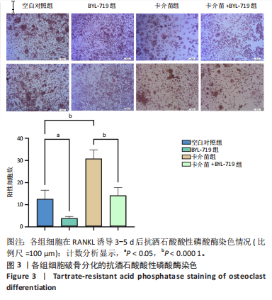
酸性磷酸酶阳性细胞(在镜下可见胞质内酶活性部位呈红橙色,细胞核内呈阴性)被鉴定为成熟破骨细胞。结果显示,卡介苗组抗酒石酸酸性磷酸酶阳性多核破骨细胞较空白对照组明显增多(P < 0.000 1),而卡介苗+ BYL-719组的抗酒石酸酸性磷酸酶阳性细胞较卡介苗组显著减少(P < 0.000 1),见图3。 2.4 鬼笔环肽染色检测BYL-719对结核杆菌感染下破骨融合能力的影响 各组RAW264.7细胞RANKL诱导破骨分化3-5 d后,进行鬼笔环肽染色测定。鬼笔环肽能结合和稳定丝状肌动蛋白,通过荧光可视化显示出微丝骨架在细胞中的分布。结果显示,卡介苗组破骨细胞的丝状肌动蛋白环较空白对照组明显增大,而在BYL-719干预后,这一过程被抑制,见图4。提示BYL-719可以抑制结核杆菌感染下破骨细胞的融合能力。 2.5 RT-qRCP检测破骨分化相关基因的表达 各组用RANKL处理3-5 d后提取细胞总RNA,进行反转录 RT-qRCP检测破骨相关基因c-Fos、NFATc1、CtsK和MMP9的表达。结果显示,卡介苗组在结核杆菌感染后促进了c-Fos、NFATc1、CtsK和MMP9的表达(P < 0.05),而在BYL-719干预后,这一过程被明显抑制(P < 0.05),见图5。 "

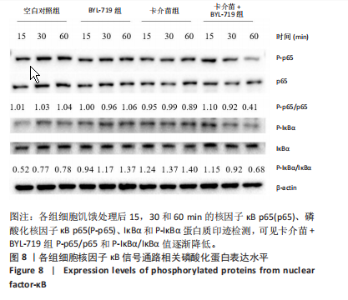
2.8 BYL-719通过抑制核因子κB p65的核转位抑制结核杆菌诱导的破骨细胞生成 为了进一步研究潜在机制,将各组RAW264.7细胞用RANKL诱导72 h(卡介苗感染于铺板24 h后进行),在没有胎牛血清的情况下饥饿细胞12 h,各组分别处理细胞15,30和60 min。对核因子κB p65、磷酸化核因子κB p65、IκBα和P-IκBα进行蛋白质印迹检测。结果表明,在结核杆菌感染下,BYL-719对IκBα的总量影响不大,但下调了P-IκBα,从而明显降低了P-IκBα与IκBα比值。因此,IκBα降解减少,抑制了p65的磷酸化并阻止了p65/p50异二聚体核移位,见图8。此外,通过对核因子κB p65进行免疫荧光染色观察到,在RANKL诱导下,核因子κB p65的核转位较明显,核内出现淡绿色荧光,而卡介苗感染再次加强了这一过程,核内荧光信号升高;重要的是,当使用BYL-719干预时,核因子κB p65的核内绿色荧光再次减弱,提示BYL-719能抑制核因子κB p65的核转位,见图9。"

| [1] BAGCCHI S. WHO’s Global Tuberculosis Report 2022. Lancet Microbe. 2023;4(1):e20. [2] 徐彩红,赵雁林.从《2020年全球结核病报告》看我国结核病防治工作[J].中华传染病杂志,2021,39(7):392-397. [3] AGASHE VM, JOHARI AN, SHAH M, et al. Diagnosis of Osteoarticular Tuberculosis: Perceptions, Protocols, Practices, and Priorities in the Endemic and Non-Endemic Areas of the World-A WAIOT View.Microorganisms. 2020;8(9):1312 . [4] KHANNA K, SABHARWAL S. Spinal tuberculosis: a comprehensive review for the modern spine surgeon. Spine J. 2019;19(11):1858-1870. [5] 章权,石仕元,王自立.我国脊柱结核病外科治疗现状及进展[J].中国脊柱脊髓杂志,2022,32(1):75-79. [6] RAJASEKARAN S, SOUNDARARAJAN DCR, SHETTY AP, et al. Spinal Tuberculosis: Current Concepts. Global Spine J. 2018;8:96S-108S. [7] SCHWARZ EM, PARVIZI J, GEHRKE T, et al. 2018 International Consensus Meeting on Musculoskeletal Infection: Research Priorities from the General Assembly Questions. J Orthop Res. 2019;37(5):997-1006. [8] WHO consolidated guidelines on tuberculosis: Module 4: Treatment - Drug-susceptible tuberculosis treatment [Internet]. Geneva: World Health Organization. 2022. [9] HU J, LI X, CHEN Y, et al. The protective effect of WKYMVm peptide on inflammatory osteolysis through regulating NF-κB and CD9/gp130/STAT3 signalling pathway. J Cell Mol Med. 2020;24(2):1893-1905. [10] DENG J, YANG Y, HE J, et al. Vitamin D receptor activated by vitamin D administration alleviates Mycobacterium tuberculosis-induced bone destruction by inhibiting NFκB-mediated aberrant osteoclastogenesis.FASEB J. 2021;35(6):e21543. [11] LIU X, JIA W, WANG H, et al. Establishment of a rabbit model of spinal tuberculosis using Mycobacterium tuberculosis strain H37Rv. Jpn J Infect Dis. 2015;68(2):89-97. [12] TANG L, WU M, LU S, et al. Fgf9 Negatively Regulates Bone Mass by Inhibiting Osteogenesis and Promoting Osteoclastogenesis Via MAPK and PI3K/AKT Signaling. J Bone Miner Res. 2021;36:779-791. [13] PENG Q, MALHOTRA S, TORCHIA JA, et al. TREM2- and DAP12-dependent activation of PI3K requires DAP10 and is inhibited by SHIP1.Sci Signal. 2010;3(122):ra38. [14] GYŐRI D, CSETE D, BENKŐ S, et al. The phosphoinositide 3-kinase isoform PI3Kβ regulates osteoclast-mediated bone resorption in humans and mice. Arthritis Rheumatol. 2014;66(8):2210-2221. [15] SANTOS MS, LIMA VTM, BARRIONI BR, et al. Targeting phosphatidylinositol-3-kinase for inhibiting maxillary bone resorption.J Cell Physiol. 2023;238(11):2651-2667. [16] WEI L, CHEN W, HUANG L, et al. Alpinetin ameliorates bone loss in LPS-induced inflammation osteolysis via ROS mediated P38/PI3K signaling pathway. Pharmacol Res. 2022;184:106400. [17] CHEN X, CHEN W, AUNG ZM, et al. LY3023414 inhibits both osteogenesis and osteoclastogenesis through the PI3K/Akt/GSK3 signalling pathway. Bone Joint Res. 2021;10(4):237-249. [18] SALHOTRA A, SHAH HN, LEVI B, et al. Mechanisms of bone development and repair. Nat Rev Mol Cell Biol. 2020;21(11):696-711. [19] HU K, SHANG Z, YANG X, et al. Macrophage Polarization and the Regulation of Bone Immunity in Bone Homeostasis. J Inflamm Res. 2023;16:3563-3580. [20] MA W, JIN W, HE X, et al. Mycobacterium tuberculosis Induced Osteoblast Dysregulation Involved in Bone Destruction in Spinal Tuberculosis. Front Cell Infect Microbiol. 2022;12:780272. [21] BAE S, KIM K, KANG K, et al. RANKL-responsive epigenetic mechanism reprograms macrophages into bone-resorbing osteoclasts. Cell Mol Immunol. 2023;20(1):94-109. [22] SUN Y, LI J, XIE X, et al. Recent Advances in Osteoclast Biological Behavior. Front Cell Dev Biol. 2021;9:788680. [23] ASAGIRI M, TAKAYANAGI H. The molecular understanding of osteoclast differentiation. Bone. 2007;40(2):251-64. [24] JIANG W, JIN Y, ZHANG S, et al. PGE2 activates EP4 in subchondral bone osteoclasts to regulate osteoarthritis. Bone Res. 2022;10(1):27. [25] BEDARD M, VAN DER NIET S, BERNARD EM, et al. A terpene nucleoside from M. tuberculosis induces lysosomal lipid storage in foamy macrophages. J Clin Invest. 2023;133(6):e161944. [26] 王瀚,曹新生,张舒.破骨细胞体外培养技术[J].中国骨质疏松杂志,2014,20(11):1284-1289. [27] ZANG L, KAGOTANI K, NAKAYAMA H,et al. 10-Gingerol Suppresses Osteoclastogenesis in RAW264.7 Cells and Zebrafish Osteoporotic Scales. Front Cell Dev Biol. 2021;9:588093. [28] ONO T, NAKASHIMA T. Recent advances in osteoclast biology. Histochem Cell Biol. 2018;149:325-341. [29] PARK JH, LEE J, LEE GR, et al. Cholesterol sulfate inhibits osteoclast differentiation and survival by regulating the AMPK-Sirt1-NF-κB pathway. J Cell Physiol. 2023;238:2063-2075. [30] LIN X, XU F, ZHANG KW, et al. Acacetin Prevents Bone Loss by Disrupting Osteoclast Formation and Promoting Type H Vessel Formation in Ovariectomy-Induced Osteoporosis. Front Cell Dev Biol. 2022;10:796227. [31] CHEN Y, ZHANG J, GE X, et al. Vitamin D receptor inhibits nuclear factor κB activation by interacting with IκB kinase β protein. J Biol Chem. 2013;288:19450-19458. [32] SCHWARTZ C, WILLEBRAND R, HUBER S, et al. Eosinophil-specific deletion of IκBα in mice reveals a critical role of NF-κB-induced Bcl-xL for inhibition of apoptosis.Blood. 2015;125(25):3896-3904. [33] XU Y, ZHANG S, LIAO X, et al. Circular RNA circIKBKB promotes breast cancer bone metastasis through sustaining NF-κB/bone remodeling factors signaling. Mol Cancer. 2021;20(1):98. |
| [1] | Han Haihui, Ran Lei, Meng Xiaohui, Xin Pengfei, Xiang Zheng, Bian Yanqin, Shi Qi, Xiao Lianbo. Targeting fibroblast growth factor receptor 1 signaling to improve bone destruction in rheumatoid arthritis [J]. Chinese Journal of Tissue Engineering Research, 2025, 29(9): 1905-1912. |
| [2] | Zhao Jiyu, Wang Shaowei. Forkhead box transcription factor O1 signaling pathway in bone metabolism [J]. Chinese Journal of Tissue Engineering Research, 2025, 29(9): 1923-1930. |
| [3] | Zhu Hanmin, Wang Song, Xiao Wenlin, Zhang Wenjing, Zhou Xi, He Ye, Li Wei, . Mitophagy regulates bone metabolism [J]. Chinese Journal of Tissue Engineering Research, 2025, 29(8): 1676-1683. |
| [4] | Wang Wentao, Hou Zhenyang, Wang Yijun, Xu Yaozeng. Apelin-13 alleviates systemic inflammatory bone loss by inhibiting macrophage M1 polarization [J]. Chinese Journal of Tissue Engineering Research, 2025, 29(8): 1548-1555. |
| [5] | Guo Daxin, Fan Susu, Zhu Zhendong, Hou Jianhong, Zhang Xuan. Construction of lentiviral vectors for solute carrier family 1 member 5 overexpression and knockdown and stably transfected RAW264.7 cell line [J]. Chinese Journal of Tissue Engineering Research, 2025, 29(7): 1414-1421. |
| [6] | Zhao Ruihua, Chen Sixian, Guo Yang, Shi Lei, Wu Chengjie, Wu Mao, Yang Guanglu, Zhang Haoheng, Ma Yong. Wen-Shen-Tong-Du Decoction promoting spinal cord injury repair in mice [J]. Chinese Journal of Tissue Engineering Research, 2025, 29(6): 1118-1126. |
| [7] | Li Yueyao, Zhang Min, Yang Jiaju. Cistanoside A mediates p38/MAPK pathway to inhibit osteoclast activity [J]. Chinese Journal of Tissue Engineering Research, 2025, 29(6): 1144-1151. |
| [8] | Xu Tianjie, Fan Jiaxin, Guo Xiaoling, Jia Xiang, Zhao Xingwang, Liu kainan, Wang Qian. Metformin exerts a protective effect on articular cartilage in osteoarthritis rats by inhibiting the PI3K/AKT/mTOR pathway [J]. Chinese Journal of Tissue Engineering Research, 2025, 29(5): 1003-1012. |
| [9] | Xiao Fang, Huang Lei, Wang Lin. Magnetic nanomaterials and magnetic field effects accelerate bone injury repair [J]. Chinese Journal of Tissue Engineering Research, 2025, 29(4): 827-838. |
| [10] | Li Tingyue, Guo Qian, He Wenxi, Wu Jiayuan. Long noncoding RNA TP53TG1 promotes odontogenic and osteogenic differentiation of stem cells from the apical papilla [J]. Chinese Journal of Tissue Engineering Research, 2025, 29(36): 7776-7782. |
| [11] | Lu Xiuli, Xu Huazhen, Chen Yuxing, Yao Nan, Hu Zixuan, Huang Dane. Mechanism of Jiangu Formula in treating osteoporosis based on osteoclast-osteoblast coupling [J]. Chinese Journal of Tissue Engineering Research, 2025, 29(32): 6828-6835. |
| [12] | Yao Wenxin, Wang Yi, Cai Lin, Feng Xiaobo. Plant-derived exosome-like nanovesicles stimulate osteoblasts, inhibit osteoclasts, and promote osteogenesis [J]. Chinese Journal of Tissue Engineering Research, 2025, 29(31): 6765-6771. |
| [13] | Yang Cheng, Li Weimin, Ran Dongcheng, Xu Jiamu, Wu Wangxiang, Xu Jiafu, Chen Jingjing, Jiang Guangfu, Wang Chunqing. Ferroptosis and osteoporosis [J]. Chinese Journal of Tissue Engineering Research, 2025, 29(3): 554-562. |
| [14] | Wu Wangxiang, Ran Dongcheng, Xu Jiamu, Xu Jiafu, Chen Jingjing, Wang Chunqing. Long noncoding RNAs related to osteoporosis: current research status and developmental trends [J]. Chinese Journal of Tissue Engineering Research, 2025, 29(29): 6360-6368. |
| [15] | Li Zeming, Zhang Yuntao, Wang Maolin, Hou Yudong. Role and mechanism of hypoxia-inducible factor 1 alpha regulating bone homeostasis in oral and maxillofacial diseases [J]. Chinese Journal of Tissue Engineering Research, 2025, 29(26): 5680-5687. |
| Viewed | ||||||
|
Full text |
|
|||||
|
Abstract |
|
|||||
